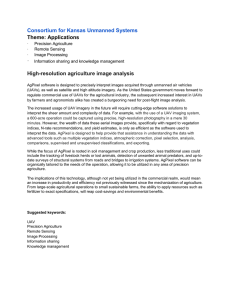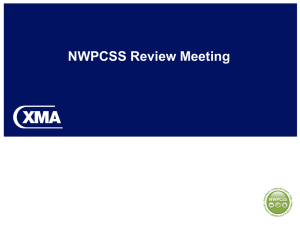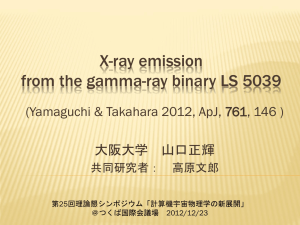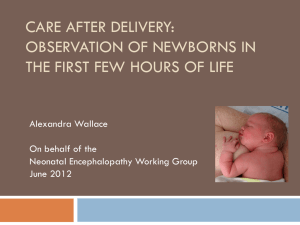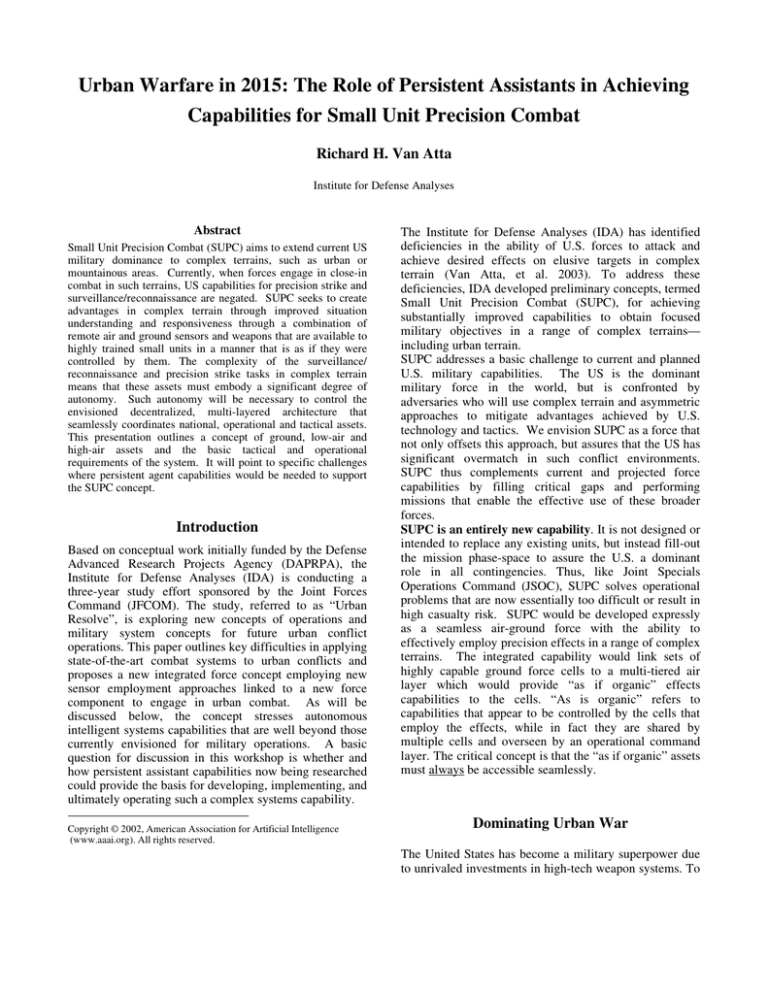
Urban Warfare in 2015: The Role of Persistent Assistants in Achieving
Capabilities for Small Unit Precision Combat
Richard H. Van Atta
Institute for Defense Analyses
Abstract
Small Unit Precision Combat (SUPC) aims to extend current US
military dominance to complex terrains, such as urban or
mountainous areas. Currently, when forces engage in close-in
combat in such terrains, US capabilities for precision strike and
surveillance/reconnaissance are negated. SUPC seeks to create
advantages in complex terrain through improved situation
understanding and responsiveness through a combination of
remote air and ground sensors and weapons that are available to
highly trained small units in a manner that is as if they were
controlled by them. The complexity of the surveillance/
reconnaissance and precision strike tasks in complex terrain
means that these assets must embody a significant degree of
autonomy. Such autonomy will be necessary to control the
envisioned decentralized, multi-layered architecture that
seamlessly coordinates national, operational and tactical assets.
This presentation outlines a concept of ground, low-air and
high-air assets and the basic tactical and operational
requirements of the system. It will point to specific challenges
where persistent agent capabilities would be needed to support
the SUPC concept.
Introduction
Based on conceptual work initially funded by the Defense
Advanced Research Projects Agency (DAPRPA), the
Institute for Defense Analyses (IDA) is conducting a
three-year study effort sponsored by the Joint Forces
Command (JFCOM). The study, referred to as “Urban
Resolve”, is exploring new concepts of operations and
military system concepts for future urban conflict
operations. This paper outlines key difficulties in applying
state-of-the-art combat systems to urban conflicts and
proposes a new integrated force concept employing new
sensor employment approaches linked to a new force
component to engage in urban combat. As will be
discussed below, the concept stresses autonomous
intelligent systems capabilities that are well beyond those
currently envisioned for military operations. A basic
question for discussion in this workshop is whether and
how persistent assistant capabilities now being researched
could provide the basis for developing, implementing, and
ultimately operating such a complex systems capability.
Copyright © 2002, American Association for Artificial Intelligence
(www.aaai.org). All rights reserved.
The Institute for Defense Analyses (IDA) has identified
deficiencies in the ability of U.S. forces to attack and
achieve desired effects on elusive targets in complex
terrain (Van Atta, et al. 2003). To address these
deficiencies, IDA developed preliminary concepts, termed
Small Unit Precision Combat (SUPC), for achieving
substantially improved capabilities to obtain focused
military objectives in a range of complex terrains—
including urban terrain.
SUPC addresses a basic challenge to current and planned
U.S. military capabilities. The US is the dominant
military force in the world, but is confronted by
adversaries who will use complex terrain and asymmetric
approaches to mitigate advantages achieved by U.S.
technology and tactics. We envision SUPC as a force that
not only offsets this approach, but assures that the US has
significant overmatch in such conflict environments.
SUPC thus complements current and projected force
capabilities by filling critical gaps and performing
missions that enable the effective use of these broader
forces.
SUPC is an entirely new capability. It is not designed or
intended to replace any existing units, but instead fill-out
the mission phase-space to assure the U.S. a dominant
role in all contingencies. Thus, like Joint Specials
Operations Command (JSOC), SUPC solves operational
problems that are now essentially too difficult or result in
high casualty risk. SUPC would be developed expressly
as a seamless air-ground force with the ability to
effectively employ precision effects in a range of complex
terrains. The integrated capability would link sets of
highly capable ground force cells to a multi-tiered air
layer which would provide “as if organic” effects
capabilities to the cells. “As is organic” refers to
capabilities that appear to be controlled by the cells that
employ the effects, while in fact they are shared by
multiple cells and overseen by an operational command
layer. The critical concept is that the “as if organic” assets
must always be accessible seamlessly.
Dominating Urban War
The United States has become a military superpower due
to unrivaled investments in high-tech weapon systems. To
name a few advantages, the US has stockpiles of
autonomous weapons, sophisticated rapid targeting and
air power management, training facilities and automated
logistics supported by a large industrial base. The crux of
urban warfare is that the effectiveness of standoff sensors
and precision weapons is severely diminished in the face
of 3D, complex, transient terrain, with its short range lineof-sight and overwhelming target discrimination issues.
Military planners who, in the non-urban environment
optimize deployment schemes, in the urban environment
must choose between collateral damage and casualties.
The urban enemy has the ability to blend with a civilian
population and conceal small weapons that are highly
effective in close combat situations. The hidden enemy
can conduct raids and ambushes at their choosing. Our
inability to engage this kind of enemy with precision
munitions or rapid response with overwhelming force
means that the urban playing field is a much more level
one.
A New Operational concept
A Roadmap was created under a previous IDA study that
separates the problem into a formula known as USECT =
Understand, Shape, Engage, Consolidate, Transition.
USECT conveys a new, more precise strategy to urban
conflict over more traditional fighting strategies (Hurley,
2001). Urban Resolve will use the USECT strategy as the
foundation for the creation of a new operational concept
and to drive the focus for new force capabilities and
technology needs. The projection of overwhelming force
concentrations that can react to enemy maneuvers in
extreme urban environments, requires a change in
thinking. For instance, the hardest of targets in urban
areas are sometimes “soft-targets” that are extremely well
concealed or blended with non-combatants.
IDA’s research has identified in its SUPC operational
concept key force components that may play a role in the
future of urban warfare. SUPC is an air-centric operation
complemented by a small, highly maneuverable ground
component. Air power addresses the need for rapid
maneuvering of force concentrations throughout complex
urban terrain. Effective fighting also requires a presence
on the ground. SUPC ground forces will employ persistent
fusing of intelligence, surveillance and reconnaissance
(ISR) with the operating environment they are
experiencing close at hand. Ground forces will require
access to a broad range of ISR sources and the capability
to rapidly employ air delivered weapons.
If a SUPC capability existed it would significantly expand
the operational domain of US forces along multiple
dimensions:
Time. SUPC enables extremely rapid (24hrs), “focused
intervention” or strike in all theaters worldwide with
precision. This is much faster than current forces can
respond.
Complex Terrain. SUPC is designed specifically to
operate in complex terrain. Current and projected forces
are optimized for open terrain and suffer significant
degradation as terrain becomes more complex.
Critical & Elusive Targets: SUPC is designed to find
critical & elusive targets and enable the employment of
appropriate effects (ranging from destruction through
capture to persistent surveillance, etc.). In essence SUPC
is a “tactical reconnaissance strike complex.” Current
forces are often challenged in locating specific targets
(e.g. Iraqi SCUDS) and generally have a limited choice
when delivering timely effects - destruction.
Anti-access: SUPC is designed for assured access. It does
not depend on extensive basing and overflight and has a
relatively small logistics tail. It can penetrate air defenses,
and rapidly neutralize them (combination of stealth,
redundancy and suppression). It simply obviates antiaccess capabilities of the adversary. Current forces (with
the exception of stealth aircraft) still face a major antiaccess challenge that require significant time and
resources to resolve.
Mission Range: Because of these new capabilities, SUPC
expands the mission range of the Armed Forces and offers
true jointness of operations. Example scenarios include:
no notice covering force to delay/disrupt invasion of
friendly country; low profile terrain control to prevent
ethnic cleansing; and, rapid attack of critical target in
urban terrain. These and other missions are beyond the
scope of current forces without significantly more time,
resources and preparation than SUPC requires.
Situational Understanding/ Discreteness/ Focus: SUPC
gives the operational commander the ability to gain
exquisite situational understanding (SU) of critical
focused objectives while maintaining a small discrete
footprint. The SU answers questions about the ground
truth that cannot otherwise be determined (e.g. sorting
actual targets from decoys or armed enemies from
civilians) and which must be answered to succeed in the
mission. Among current forces only small elements of
Special Operations Forces (SOF) are designed to
accomplish a similar mission but with major limitations
relative to SUPC.
Scale, Scope, Flexibility: SUPC is modular at the
operational and tactical levels and is therefore scalable. It
is entirely tailored to the mission and can range from a
single cell, to multiple cells in a small area (e.g. urban) to
even larger numbers widely dispersed over a wide area.
This, along with small footprint and logistics
requirements, creates great flexibility in employment.
Current forces are normally task-organized for missions,
but their structure, command and control, logistics and
customs make them far less modular and scalable than
SUPC and therefore far less flexible.
Jointness: Because SUPC was invented to solve a set of
difficult problems through zero based analysis it is totally
and inherently joint. Much like JSOC, it was created as a
solution that required permanent integration of
capabilities normally provided by different Services. This
permanent integration creates synergies unachievable
through current joint integration processes even if
improved through the Standing Joint Task Force
initiative. Accordingly among current forces only JSOC is
on a par with SUPC but it is organized and structured for
a different mission (complementary to but distinct from
SUPC).
SUPC Mission
The SUPC Force assumes Urban Warfare as a primary
mission focus. It is a horizontal force, a scaleable
collection of small units that each work independently
under specific commander’s intent. SUPC is a light force
with a quick response time, capable of engaging a much
larger enemy force. The mission areas for the SUPC force
will include urban strike, urban force engagement, and
capture of critical nodes or centers of gravity in the urban
complex.
SUPC will require relatively light logistics and will rely
on CONUS basing and transcontinental air routes.
Insertion of forces, sensors, and a tiered architecture of
air-based and air delivered systems will function in an
“as-if-organic” fashion. All assets will be virtually linked
to the SUPC ground units. Space-based and high-altitude
platforms are expected to provide surveillance and
communications reach-back, theater command support
and remote precision strike. Medium to low altitude assets
will be used to insert, support, and extract forces, sensors,
and weapons. Low altitude air assets are envisioned to be
numerous, semi-autonomous, continuously replenished,
and dedicated to a controlling “cell” of operations.
SUPC Warfighter Capabilities
The SUPC warfighters would be selected and trained to
operate in an environment that requires quick reaction,
close combat skills be seamlessly linked to a largely
synthetic man-machine interface. Similar to the tactical
aircraft pilot who must combine instinct, training and
split-second skill to apply human decision-making and
control to a complexly integrated machine, the SUPC
warfighter must be a master of virtual command and
control. The SUPC warfighter will apply human decisionmaking and intent to expert systems, controlling ISR
assets, data fusion, and other information needs. These
may be clandestine operations and will likely involve
beyond-line-of-sight engagements. The “as-if-organic”
control over the range of available assets from
information agents, to unattended sensors to weapons
platforms is the ultimate systems challenge.
New technologies must evolve to meet the 2015 vision.
Command and control equipment and capabilities for this
new “road” warrior have unique requirements—entailing
autonomy and intelligence—that extend well beyond
current military equipment.
A “silent” troop
transportation system for rapid stealthy insertion of SUPC
troops into an urban environment requires new thinking,
possibly with more emphasis on autonomously operated
VTOL UAVs.
New emphasis will be given to technology that enhances
the minds and bodies of these urban warfighters. Urban
camouflage requires adaptation of clothing and physical
appearance. Military uniforms may require diversions into
urban or culturally matched styles. A personal assistant
device that aids intelligence and increases survivability in
urban areas may be just as important as the survival gear
of today’s foot soldiers. This kind of item may include
synthetic voice translation that allows warfighters to
converse in native vernacular to aid intelligence gathering
and to increase survivability.
The ability of SUPC warfighters to obtain accurate
situation understanding that precedes split-second
decisions is likely to be the most critical technology.
Presentation of data from “as-if-organic” ISR sensors and
assets that support the SUPC warfighter must come in a
form that is extremely portable and even clandestine.
Augmented reality systems that combine “see-through”
and “hear-through” synthetic data overlaid onto the real
environment may hold solutions.
URBAN RESOLVE 2015 Wargame
The complete SUPC concept of operations is being
studied in the Urban Resolve wargaming experiment.
Urban Resolve is a three-phase exercise simulating an
urban conflict within a Far Eastern city in 2015. The
proposed SUPC concept will be evaluated in deliberative
scenarios, and new capabilities introduced incrementally
during the exercises. The three phases are as follows:
Phase 1: Intelligence Preparation of Battlespace
Phase 2: Precision Strike
Phase 3: Nodal Capture
In the wargame, complete force structures will be created
in detail spanning the range of capabilities proposed to be
employed in the 2015 timeframe.
The purpose of the Urban Resolve wargame is to enact
the new system capabilities that may be developed to
support the overall concept of operations of SUPC. Each
new capability, from evolutionary modifications to
existing platforms and systems to major system
acquisitions, must be accurately represented in the Urban
Resolve synthetic environment. Human-in-the-loop
(HITL) operators will participate within the synthetic
arena and will be capable of manipulating assets at any
time during the game play. HITL operators will manage
Red, Blue, and Green (non-combatant) forces. The current
simulation environment is capable of modeling
approximately 50,000 buildings, 140,000 green forces
(both vehicles and foot traffic) as well as tens of
thousands of red and blue forces and sensor assets.
Operators will have the opportunity to develop strategy
throughout multiple series of simulations. The HITL
interface to the synthetic arena will enable real-time
control of forces and assets, therefore counterstrategies
can be exercised within a game cycle. The successes and
failures of the HITL wargames will be the impetus for
evolving the SUPC concept and the proposed assets and
sensor capabilities.
URBAN RESOLVE Pilot
Phase 1 of the Urban Resolve wargame has been
completed, with analysis of its results now underway. It
concentrated on the construction of forces and assets that
to be portrayed in the simulated environment including
“innovations” in critical system capabilities that do not
exist in the present based on detailed modeling of
performance parameters. Items integral to SUPC are:
persistent UAVs, relocatable unattended sensors that rely
on small UAVs to maneuver and perch, other ISR
approaches for large volumetric coverage, new
communications and signals intelligence and data
reduction approaches, autonomous UAV flight control,
sensor and target referencing, multi-hypothesis sensing
and tracking capabilities to discriminate against “urban
camouflage”, and persistent & multimode sensor track
fusion to discern targets from their behavior.
The models in phase 1 addressed sensor employment as
well as sensor vulnerabilities and attrition. Blue force
camouflage and counter-countermeasures were included.
A communications architecture was developed for
networking thousands to tens of thousands of mobile,
multi-modal sensor nodes. These nodes must filter data at
the sensor and collaborate to create seamless,
geographically based information library products that are
available all levels of users.
Future phases of the wargame will address precision
weaponeering in urban environments. Major system
acquisitions are envisioned to address operation in terrain
that requires extreme precision in areas with extreme
clutter. At a minimum the weapons assets will include
loitering “killer” UAVs and “arsenal” UAVs that will
carry and insert multiple forms of precision lethal and
non-lethal weapons into the battlespace.
Logistics
support must accommodate a large variance in product
configuration and customization. This will also be
modeled and played in latter phases of the wargame.
SUPC—Tactical Concept
Prior to deployment, the SUPC cells are fully trained,
their equipment containerized for airdrop. The cells can
assemble 100% within one hour of notification. Once
alerted and enroute to the objective area, the Cell
Commander begins mission planning in parallel with the
Operational Commander’s planning, using robust
information tools that enable real-time intelligence
gathering and dissemination, as well as variety of
simulations to facilitate rehearsals.
Once the Operational Commander has established the
conditions in and around the SUPC area of operations to
enable cell insertion, the unit will conduct a covert
airborne insertion, either as a cell or in small groups.
Once on the ground, the cell will immediately establish
local security by relying upon robust ISR for SU and
stealth for protection. Exquisite SU will enable the cell to
maneuver to avoid direct contact with Red forces or send
targeting data to responsive joint fires and engaging Red
forces at standoff distances.
On the ground, the cell may break into small sub-elements
if needed. It will “plug” into the system of air and ground
sensors the Operational Commander established (with
input from the Cell Commander) prior to insertion, and
augment that system with additional sensors to develop
the fidelity of SU the mission requires. As they develop
the situation on the ground, they will adjust that sensor
perimeter as required, either in an effort for greater
clarity, or as a response to additional tasking and/or Red
forces. Their mobility is limited to foot movement over
short distances; greater distances would require the cell to
reposition via air.
All support will be delivered by air. The Cell commander
will directly control some of those air assets, particularly
some fires and ISR, but others will remain under the
Operational Commander’s control. Air delivered support
includes all fires above the small arms needed for
personal protection, but also extends into logistical
support such as casualty evacuation, resupply, and
information processing.
The cell normally seeks to avoid close contact with Red
forces and as mentioned, prefers to engage them at
standoff distances. In the event that Red forces close
upon the cell, the cell will attempt to reposition and in
conjunction with the Operational Commander’s assets,
will always have a final protective fire and break contact
capability consisting of their own small arms, the ability
to surge a high volume of extremely responsive precision
fires, a family of smart barriers with non-lethal (e.g.,
millimeter wave) and other personnel and vehicular
counter-mobility measures, multi-spectral smoke and
other means to destroy, disable or spoof enemy forces.
In those instances when close contact is required for
mission accomplishment (e.g. urban terrain) exquisite SU
will assure SUPC the advantage of surprise, the ability to
shape the close battle space, and low latency precision
weapons to provide a major advantage even against
significantly larger numbers.
national technical assets and satellites that provide an
overarching ISR capability in theater. In addition, theater
specific air assets, termed high air, provide remote RSTA
and reconfigurable precision strike at the fingertips of the
operational command. The primary flow of information in
the high air layer is to the operational commander, whom
may choose to push selected information to the SUPC
Cell commander to enhance the tactical level situational
understanding.
The operational commander can also “reach down” into
the top most portion of the tactical low air layer to adjust
availability of effects across multiple SUPC cells and/or
re-enforce/resupply the low air layer. This is done in a
manner that is transparent to the SUPC Cell commander
to assure robust “as if organic” capabilities on the ground.
SUPC Operational-Level Architecture
As shown below, the SUPC concept has a multi-layered
architecture that seamlessly coordinates national,
operational, and tactical assets. With the exception of the
tactical cells on the ground, all assets are airborne during
the operation. A natural delineation in the overall SUPC
architecture is between the operation and tactical layers.
These two layers can be thought of as having different
command and control centers and nodes for information
flow.
The operational-level architecture is centered about the
operational commander, who may or may not be in
theater, but is not on the ground near the area of
operations. The operational-level architecture includes
SUPC Operational-Level Architecture
Space
Surveil
- National technical assets
- Satellites - Surveillance & comms
High Air (>15Kft)
Surveil & Fires
Low Air
- Remote RSTA
- Remote precision strike
- Insertion,
support &
(<15Kft) extraction
Surveil, Fires,
Insertion, & Extraction
- Local RSTA
- Local Strike
•
•
•
•
“Guardian Angel” UAV
“Arsenal” UAV
UAV Air Refueling
Cell Transporter
•
•
•
•
Small “Go Anywhere” UAVs
ID Sensors
UGS
Tags
• Tunable Effects Barriers
• Loitering Airborne Munitions
Swarm
• All-Weather Designators
SUPC Operations
The operational command controls the air bridge, the
high air layer and the flow of supplies into and
reallocation of capabilities into the low air layer. The
high air layer consists of unmanned air vehicles (UAVs)
that have one of two primary missions, sensing or
shooting. All UAVs are assembled in an ad-hoc, selfhealing network. A distributed “master processor” and
multiple gateways control dynamic scheduling,
deconfliction and coverage. The decentralization of the
“master controller” assures system robustness against
failure or loss of individual platforms. The gateways
provide a link between the operational layer and the
tactical layer.
Given that the operational layer must provide the top
level umbrella coverage to the SUPC Cells on the
ground, the UAVs must have significant loiter time and
be air refueled to assure continuous coverage. This
implies an additional supporting element of aircraft that
might be positioned at standoff, for resupply and
refueling. In addition, an air bridge to a ground or sea
based supply depot (potentially CONUS) for theater
replenishing is critical.
At the tactical level the SUPC consists of an “as if
organic” networked air layer that provides significant
sensing and all effects other than the personal weapons
carried by the SUPC Cell. This tactical or low air layer
has an array of both sensor UAVs and shooter UAVs. In
addition, the layer contains UAVs that act as distributed
Processors, communication Nodes, and Gateways
(PNGs) to the operational layer. The ground layer
contains the SUPC cell members and all emplaced or
dropped sensors. These sensors coupled with the air layer
through ground based PNGs provide the exquisite
situational awareness.
Tactical-Level Systems
OPERATIONAL SUPPORT
OPERATIONAL AIR ASSETS
Air assets
dedicated to cell
TACTICAL AIR NET
SENSOR UAVs
SHOOTER UAVs
PNG UAVs
Redundant, self-healing net
Cell commander on
ground controls all
of these assets.
GROUND NET
Cell on ground
TROOPS
SENSORS
PNGs
Redundant, self-healing net
PNG = Processor, Node, and Gateway
41
Tactical Network
The tactical network has both air and ground
components. The network nodes are collocated with the
sensor and shooter air nodes and the unmanned ground
sensors (UGS) and SUPC Cell members. The network is
fully ad-hoc, self-organizing, and self-healing. The
network is based on an open architecture to permit rapid
integration of additional capabilities. To assure overall
power efficiency, the tactical network nodes must
maximize embedded processing capability to achieve a
fully
distributed
system.
Although
multi-hop
communications is an underlying feature of the network,
routing paths from the ground to air layer must be
optimized to minimize sensor to shoot latency.
Persistent Assistant Capabilities Needed
Of the capabilities needed for the SUPC concept six have
been identified as critical. These are: survivable air
operations; persistent UAVs; robust communications for
100s to 1000s of nodes; automatic control of all force
elements and automatic updating of SU; ability to detect,
classify and assess effectiveness of all red forces posing
an imminent threat to blue forces; and delivery of lethal
effects with precision, low latency, and high accuracy.
For most of these critical capabilities the state of
assessment and control systems needed appears to be
well beyond current systems. In particular, an intelligent
system with persistent assistants is called for that would
allow a system of this complexity to be self maintaining
with limited direction of individual elements by human
operators. Some specific challenges where persistent
agent capabilities appear to be needed to support the
SUPC concept in terms include:
Capability Needed - Place sensors and effects (lethal
and non-lethal) anywhere throughout battlespace
based on human-generated insights
Problem - Means to locate, detect/confirm target,
allocate appropriate asset (sensor or effect0 with nearzero latency
Capability Needed - Robust communications between
hundreds of nodes
Problem - Self-assembling, self-healing, high-data-rate,
“work anywhere” networks (with highly robust and
miniaturized components)
Capability Needed - Automatic force element control
and continuous SU updating
Problem - Efficient, easily-reprogrammable, fail-safe
information/decision-making processing that fuses sensor
data, derives and passes “situation understanding” SU to
combatants, and maintains and delivers cell resources
Capability Needed - Persistent UAVs
Problem - Means to maintain a configuration, redirect or
redeploy based on unfolding events; replace and refuel
multiple UAVs, large and small, under any conditions
Summary
SUPC is a concept for a new force component that will
enable battlespace superiority in a landscape that has
challenged US military planners. Goals of this effort are
complete system architectures to the level of detailed
requirements for weapons matched to the environment,
forces equipped to survive and overwhelm the
opposition, and sensors offering the precision and
discrimination to minimize collateral damage.
SUPC is a novel, seamlessly integrated air-ground
combat force that fills in the operational spectrum
complementing current force structure. It is designed for
rapid deployment worldwide, small on-ground foot print
and optimized for the most complex terrain (jungle,
mountains, and MOUT). SUPC employs a multi-layered
architecture that assures modularity for the operational
commander. Sustainable high air and low air layers
provide exquisite ISR and a full spectrum of low latency
precision effects at the finger tips of both the operational
and tactical commanders. Each 15-man SUPC cell can
direct action that ranges from surgical non-lethal nodal
attacks up to engagement of forces orders of magnitude
larger. The dynamic range of operations is enabled by
exquisite situational understanding and the low latency
effects.
Small Unit Precision Combat (SUPC) aims to
substantially transform the effectiveness of US military
capabilities in complex terrains, such as urban or
mountainous areas. Currently, when forces engage in
close-in combat in such terrains, US capabilities for
precision strike and surveillance/reconnaissance largely
are negated. SUPC contemplates creating a similar
advantage in complex terrain through improved situation
understanding generated by a combination of air and
ground sensors and weapons available to highly trained
small units in a manner that is available to these units as
if they were controlled by them.
However, the
complexity of the surveillance/ reconnaissance and
precision strike tasks in complex terrain means that these
assets must embody a significant degree of autonomy.
Such autonomy will be necessary to control the
contemplated decentralized, multi-layered architecture
that seamlessly coordinates national, operational and
tactical assets. Specific challenges where persistent
agent capabilities would be needed to support the SUPC
concept include: (1) loitering swarms of unmanned aerial
vehicles that act cooperatively to support cells on the
ground with both ISR and weapons; (2) the control of
remote nonlethal weapons to protect forces and engage
targets; and (3) intelligent indirect personal weapon
systems that identify obstructed targets and select the
ideal strike method from remote weapons. For the entire
system concept the multi-layered management and
control system requires a high level of autonomous
allocation of assets across distributed operators and the
ability to manage sustainment and replenishment.
References
Van Atta, R., K. Carson, W. Freeman, T. Altshuler, John
Transue, and Mark Lewis, October 2003. Small Unit Precision
Combat: Attacking Elusive Targets in Complex Terrain.
Alexandria, VA: Institute for Defense Analyses, IDA
Document D-2860.
Hurley, William, August 2001. Taking the Revolution in
Military Affairs Downtown: New Approaches to Urban
Operations, Alexandria, VA: Institute for Defense Analyses
IDA Paper P-3593.


